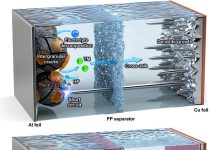
Scientists have made a major breakthrough in controlling the atomic structure of halide perovskites, a promising class of materials that could change the future of solar energy, lighting, and quantum technologies.
By building perovskite films one atom-thin layer at a time, researchers from the University of Cambridge have created a highly controlled, finely tuned “energy sandwich” that could lead to more powerful and durable solar cells, LEDs, lasers, and other electronics.
Perovskites have attracted enormous interest over the past decade because they absorb and emit light far better than silicon, the material used in most solar panels today.
They are also cheaper to make and can convert more of the sun’s energy into electricity.
But perovskites come with a major drawback: they are unstable. Heat, moisture, and even light can degrade them, making them difficult to use in real-world products.
Another challenge is that researchers have struggled to control the thickness of perovskite layers or understand how stacked layers interact—both crucial steps for building useful semiconductor devices.
The Cambridge team has now overcome these barriers. Using a vapor-based process—the same method used to make commercial semiconductors—they grew perfectly aligned layers of both 3D and 2D perovskites, one atomic layer at a time.
This allowed them to precisely tune the thickness and structure of each layer, something that was nearly impossible with the usual liquid-based methods.
Their work, published in Science, shows that this ultra-precise method unlocks a new level of control over how perovskites absorb and emit light.
In semiconductor devices, each layer has a specific job, guiding negatively charged electrons and positively charged “holes” in different directions.
These layers act like one-way streets, preventing the particles from colliding and wasting energy. Until now, perovskites behaved too chaotically at the atomic level to control this movement effectively.
With vapor processing, however, the team achieved epitaxial growth—a method that forces atoms to line up neatly from one layer to the next. This precision allowed them to watch how the material’s light-emitting properties changed depending on whether it had one layer, two layers, or more.
They also discovered they could manipulate how electrons and holes behaved at the boundaries between layers. By subtly adjusting the growth conditions, they could either keep charges together (useful for LEDs) or pull them apart (useful for solar cells).
The researchers were able to tune the energy difference between layers by more than half an electron volt—an enormous amount—and extend the lifetime of electrons and holes to over 10 microseconds, much longer than in typical perovskite materials.
Longer lifetimes mean higher efficiency, brighter light emission, and more energy captured from sunlight.
This achievement could pave the way for mass-produced, high-performance perovskite devices that are more stable and easier to manufacture. It also opens new possibilities for next-generation lasers, sensors, and quantum technologies.
According to the researchers, this level of atomic control shows that perovskites can indeed be shaped into reliable semiconductors.
With further development, they could revolutionize how we make low-cost electronics, high-efficiency lighting, and solar cells that outperform today’s silicon-based technologies.



